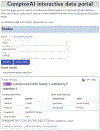Automating Predictive Toxicology Using ComptoxAI
- PMID: 35819939
- PMCID: PMC9805296
- DOI: 10.1021/acs.chemrestox.2c00074
Automating Predictive Toxicology Using ComptoxAI
Abstract
ComptoxAI is a new data infrastructure for computational and artificial intelligence research in predictive toxicology. Here, we describe and showcase ComptoxAI's graph-structured knowledge base in the context of three real-world use-cases, demonstrating that it can rapidly answer complex questions about toxicology that are infeasible using previous technologies and data resources. These use-cases each demonstrate a tool for information retrieval from the knowledge base being used to solve a specific task: The "shortest path" module is used to identify mechanistic links between perfluorooctanoic acid (PFOA) exposure and nonalcoholic fatty liver disease; the "expand network" module identifies communities that are linked to dioxin toxicity; and the quantitative structure-activity relationship (QSAR) dataset generator predicts pregnane X receptor agonism in a set of 4,021 pesticide ingredients. The contents of ComptoxAI's source data are rigorously aggregated from a diverse array of public third-party databases, and ComptoxAI is designed as a free, public, and open-source toolkit to enable diverse classes of users including biomedical researchers, public health and regulatory officials, and the general public to predict toxicology of unknowns and modes of action.
Conflict of interest statement
The authors declare the following competing financial interest(s): The authors declare no competing financial interests except T.M.P. who is a member of the Expert Panel, Research Institute for Fragrance Materials.
Figures






References
-
- Thomas RS; Bahadori T; Buckley TJ; Cowden J; Deisenroth C; Dionisio KL; Frithsen JB; Grulke CM; Gwinn MR; Harrill JA; Higuchi M; Houck KA; Hughes MF; Hunter ES; Isaacs KK; Judson RS; Knudsen TB; Lambert JC; Linnenbrink M; Martin TM; Newton SR; Padilla S; Patlewicz G; Paul-Friedman K; Phillips KA; Richard AM; Sams R; Shafer TJ; Setzer RW; Shah I; Simmons JE; Simmons SO; Singh A; Sobus JR; Strynar M; Swank A; Tornero-Valez R; Ulrich EM; Villeneuve DL; Wambaugh JF; Wetmore BA; Williams AJ The Next Generation Blueprint of Computational Toxicology at the U.S. Environmental Protection Agency. Toxicol. Sci 2019, 169, 317–332. - PMC - PubMed
-
- Atzeni P; Antonellis VD Relational Database Theory; Benjamin/Cummings Publishing Company, 1993.
-
- Richard AM; Judson RS; Houck KA; Grulke CM; Volarath P; Thillainadarajah I; Yang C; Rathman J; Martin MT; Wambaugh JF; Knudsen TB; Kancherla J; Mansouri K; Patlewicz G; Williams AJ; Little SB; Crofton KM; Thomas RS ToxCast Chemical Landscape: Paving the Road to 21st Century Toxicology. Chem. Res. Toxicol 2016, 29, 1225–1251. - PubMed
Publication types
MeSH terms
Grants and funding
LinkOut - more resources
Full Text Sources

